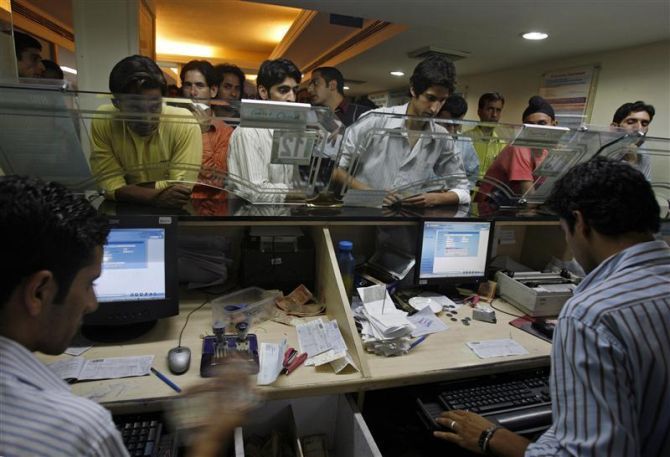The best investment schemes fail if they don't offer incentives to intermediaries to push investors, not only to start investing but to continue with it, notes Debashis Basu.
 In May this year when the government launched Atal Pension Yojana (APY), I had ventured to suggest that the scheme would struggle to be successful.
In May this year when the government launched Atal Pension Yojana (APY), I had ventured to suggest that the scheme would struggle to be successful.
The scheme has so far enrolled over a million people. Contrast this with the fact that the life insurance scheme has enrolled close to 28.6 million and the accident insurance scheme over 91.6 million.
APY penetration has been low, even accounting for the fact that the scheme is available for only those who are 40 or below.
I am not surprised because the scheme lacks a pull factor even as it expects savers to be regular with their investments.
I had mentioned that the government's initial advertising campaign would take the scheme only so far.
The best investment schemes fail if they don't offer incentives to intermediaries to push investors, not only to start investing but to continue with it.
Indeed, the worst of APY is yet to come. Remember there is a strong penalty for defaulting in contributions.
If there is no contribution for six months, the account will be frozen. After 12 months the account will be deactivated. After 24 months the account will be closed.
The APY targets workers in the informal sector. As it is, it is hard to get them to save money. Many of them do not have a fixed income and so cannot save a fixed amount of money every month.
Far from being able to save, they are also hit by big expenses from time to time, for which they get into debt.
Some 85 per cent of rural workers earn well below than the minimum wage; more than 300 million people survive on less than Rs 70 per day.
If the government intended to encourage them to save, why would it act so tough with the contributors' money as to freeze, deactivate and close their accounts?
After all the government is only putting in Rs 1,000 for the first five years. It's the contributors' own money.
In response to my piece, a director in the department of financial services wrote a letter to Business Standard arguing that these tough measures "will instill some discipline among investors to be regular in contributing their installments. Freezing, deactivating and closure of the account are designed to avoid account maintenance payment to the recordkeeping agency."
This may be a practical approach but this kind of tough stance can normally be applied in situations where the terms of the deal are highly appealing to customers, or if the customers are well-educated and are well-aware of their responsibilities.
Neither is applicable here. Indeed, when well-educated savers are callous about their investments - after all, unclaimed bank deposits or dividends run into tens of crores - can we expect better from those who are less financially literate?
The informal workers targeted are not even in a position to save regularly, as I mentioned before.
On the other hand the same government (as also the previous governments), which has imposed onerous terms on APY contributors has so far allowed businessmen to get away with willfully defaulting on tens of thousands of crores.
It is now more than six months since the two insurance schemes were launched.
When Jan-Dhan Suraksha Bima Yojana and Jeevan Jyoti Bima Yojana were launched I had expressed major apprehensions based on three aspects: one, no medical test; two, the behaviour of insurance companies; and three, the behaviour of subscribers.
If they do waive medical tests, they charge a higher premium. I also know from my experience of reviewing scores of cases that life insurance companies are keen to reject claims when they can.
How comfortable were the same insurers selling the Jeevan Jyoti Bima by taking only a self-declaration from the applicant? Not many people would have read the form fully.
If they did have a medical history and condition, would they not take advantage of the "no-medical test" and apply? How likely was that the millions who have bought the scheme from harried bank officials were guided correctly?
I suspect that many such self-declarations would be defective and create grounds for denial of claims. What is the claims experience after six months?
The accident scheme attracted 1,576 claims. Of this, 255 cases, or over 16 per cent, were rejected. This is a very high rejection rate. There were also a huge number of cases (400) pending beyond 35 days.
Given the target group, there would be many cases where claims have not even been lodged. I also notice that private insurance companies are totally unenthusiastic about the scheme.
Either the government is whipping nationalised insurance companies into selling these or they are smarter than the private ones.
In the life insurance scheme, the government website shows that, out of 8,061 claims, only 5,632 people have been paid, with a huge number "pending with insurer".
Many are pending for the past five months. The scheme will be put to a severe test next year when renewal becomes due.
There was one more scheme as part of a this bouquet of financial schemes - MUDRA for small businesses.
On Sunday, in his Mann ki Baat, the prime minister claimed that the start for MUDRA has been good (even though the Mudra Act is nowhere in sight).
As I pointed out a few weeks ago, this scheme is reporting routine small loans given by government banks as MUDRA loans.
There are reports that under pressure from the government, it is even reporting old loans as new MUDRA loans.
The insurance and pension schemes were among the first initiatives of this government.
They were cleverly populist: they were made out to be government schemes, but for which the government did not pay anything; users were made to pay for the benefits. But these schemes flouted basic principles of risk and return.
It is quite likely that those who drew up these schemes, as also MUDRA, did not care to listen to impartial experts from insurance, banking, and investing. Or even if they did, what they said was possibly brushed aside.
The writer is the editor of www.moneylife.in












 © 2025
© 2025